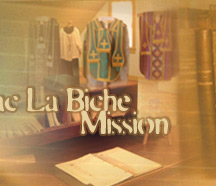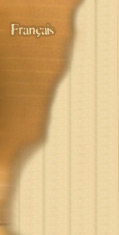Sawmill | Printing Press | Floor Mill
PRINTING PRESS
The first printing press in Western Canada
Lac La Biche Mission had the first Printing Press in Alberta. It was brought to the site by Father Emile Grouard in 1878, and could print in English, French, Beaver, Cree, and Dene.
***
 Lac La Biche Mission was home to the first printing press in Western Canada. The press was brought to Lac La Biche by the Rev. Emile Grouard, an Oblate priest of the order Mary Immaculate, in 1877. Father Grouard had been stationed at Notre Dames des Victories until, and was instrumental in the establishment and operation of the Mission. He had gone to France for health reasons the previous yea, and while he was there, he learned the art of printing. He had a syllabic type specially designed for him, and as well as a
Lac La Biche Mission was home to the first printing press in Western Canada. The press was brought to Lac La Biche by the Rev. Emile Grouard, an Oblate priest of the order Mary Immaculate, in 1877. Father Grouard had been stationed at Notre Dames des Victories until, and was instrumental in the establishment and operation of the Mission. He had gone to France for health reasons the previous yea, and while he was there, he learned the art of printing. He had a syllabic type specially designed for him, and as well as a  press that would be lightweight and relatively easy to transport.
press that would be lightweight and relatively easy to transport.
He returned to Canada, and over the next few years, Fr. Grouard printed books in several languages, including Montagnais, hare skin, Loucheux, Castor, Cree and French. A book of Chipewyan hymns was published at the Mission that year, followed shortly by a new edition of Bishop Faraud's selections from the Bible in the Chipewyan language. It was titled "Histories Sainte en Montagnais", and the volume appeared in 1878.
 The priests and bishops would go on to print hundreds of books and literature, including catechisms, hymnal books, prayer books, bibles, autobiographies and calendars. The Bishop Faraud, who had asked Grouard to bring it down in the first place, would be come well acquainted with the publishing process. When they ran out of paper, The bishop passes his him well. He made several tools, including presses, trimming knives, staplers and sewing machines that would prove invaluable to the book creation. He also worked at binding books, and made his own cardboard for the covers out of old paper. One year he managed to bind over 400 books.
The priests and bishops would go on to print hundreds of books and literature, including catechisms, hymnal books, prayer books, bibles, autobiographies and calendars. The Bishop Faraud, who had asked Grouard to bring it down in the first place, would be come well acquainted with the publishing process. When they ran out of paper, The bishop passes his him well. He made several tools, including presses, trimming knives, staplers and sewing machines that would prove invaluable to the book creation. He also worked at binding books, and made his own cardboard for the covers out of old paper. One year he managed to bind over 400 books.
 Fr. Grouard spent a lot of effort distributing his books. In 1878 he brought some of his books with him to Heart Lake. These books contained stories from the Old and New Testament. This proved to be a success, as everyone in the band figured how to read in a matter of hours and wanted to buy copies, as they understood the books so well.
Fr. Grouard spent a lot of effort distributing his books. In 1878 he brought some of his books with him to Heart Lake. These books contained stories from the Old and New Testament. This proved to be a success, as everyone in the band figured how to read in a matter of hours and wanted to buy copies, as they understood the books so well.
But In 1888, Fr. Grouard was sent to Fort Chipewyan on the western end of Lake Athabasca. He took his press with him to his new post, transporting it by dog team over some three hundred miles of frozen wilderness. In 1890 Father Grouard became Bishop of Ibra and Vicar-Apostolic of Athabasca, but he continued to operate Alberta's most northern press for many years to come, eventually coming to print in 7 languages.
After a distinguished record of service, the small hand press was brought to the oblate museum in St. Albert.
Short Instructions in Cree Language
By Reverend Father L. Balter, Oblate Missionary of Mary Immaculate
Preface
These loose leaves “do not replace Father Lacombe’s book of sermons”; this book is the bedside book of all missionaries living among Cree. In Father Lacombe’s book of sermons, missionaries will perfectly learn Cree language. Furthermore, all the Catholic Doctrine is explained in a language understandable to all Amerindians. These loose leaves would be used by those preferring reading gospels in ordinary types. Announces of annual celebrations are also published with some information about edifying stories.
Enclosed with these pages, we will find a list of errata. In order to avoid extending this list, I didn’t write words cut in two. Furthermore, many of these pages have been printed before correcting the “plaques”; therefore the accentuation is wrong in most cases.
The following examples show the importance of this accentuation.
1. Mamaskatch eka e kiskeyittamân tanisi e isihikasuyàn?
2. Mamaskatch eka e kiskeyittamàn tanisi a isihikasuyân?
1. It is surprising that I don’t know what’s
your name?
2. It is surprising that you don’t know what’s my name?
3. Tchikema e kiskeyittamàk eyikok e kitimakisiyàk...
4. Tchikema e kiskeyittamâk eyikok e kitimakisiyâk...
3. Because you and I we know how much you and I we are unhappy…
4. Because them and I we know how much them and I we are unhappy…
The first way of pronunciation will employed by the priest when he’s talking to a crowd; the second way is used when he talks to God, prays with a crowd, or on behalf of a crowd. In these instructions, the first way is more common and is easier to correct mistakes as they appear.
Editor
Edmonton, October 31, 1940
Published and edited by “La Survivance”,
Edmonton, Alberta
Importance of religion
Anotch ka kisikak ni wi kichipayittan ayamihewi-kiskinohamattuwina
kita kiskisopayiyek ttatto kekwaya e itastek kita tappwewokeyitamek ttatto
kekeway e itatsek kitchi totamek mina ayamihewi-nanattawihuwina e itastek
kita miyikawiyek kita pikkohuyek, kita otitamek kakike pimatisiwin kitchi
kisikok.
Ayis NT, pikkohuwin nama tchi eoko ka nikaneyittakwak? Tapwe “awiyak e miyo-pikkohât ot’atchakwa”, eoko mamawiyes kitchi abateyittamik; Eoko piko ketchina kitchi atuskatamik. Ota askik megwatch ki’ayanow, maka namawiya kakike ota ki ka ayananow; appo ota kiyanow wasakam, ekuyigok mitchet ki wabamanowok e nanipitchik ayisiyiniwok, kita ki otchi ketchnahuyak, wiya eoko, tapiskotch wiyawaw, kiyanow mina ketatawe ki ka ponabamikawinow. Pitane ekawiya kiyipi ekusi ispayik k’iteyitenawaw, ekusi nista kit isi pakuseyitestamatinawaw, maka kwitate, namawiya kitchi ki miyaskamik, ki ka ponabamikawinow.
Ki ka ponabamikawinow, tanisi eoko? Eoko oma, kita otchitchipayiw ketatawe iskweyatch ki kisikaminow; Kiyawinow kita poni waskawimagan, mina watikanik kita nahastaniwiw, maka kit’atchakonow tanisi ke ayittit? Tanisi ke ispayit ekuta? Ki kiskeyittenanow: Atchak kita nTawin-nipawistawew O kitchi-wiyasuwema, ekusi ekuta kita oyakittamawaw tanisi ke isi pakitinikasut naspitchi kakike tchi ittat. Ekusi ki kiskeyittenawaw eoko kakike ittawin nisweyakan, nikotowa kita miyikawinaniwik kitchi kisik, wiyawaw otchi ota askik iskweyatch isko ka ki atuskawatchik Kisemanitowa, appo Kitchiiskutew, wiyawaw otchi eka ota askik ka kik tepi-totawatchik Kisemanitowa.
Nama kekway paspiwin, niktowa piko, namawiya kita ki wimâskamik, Atawiya tapwe mna ittakun kassihamake-iskutwe, maka eoko tapiskotch sabopimutteskanaw ka itamok kitchi kisikok. E ketchinahuk maka kakiyaw eoko, ekusi e ispayik, kekway e itastek awasime kita auskatamâk megwatch e awihikowisiyûk ota askik pimatisiwin? Soskwatch kita waweyistamasuâk nema kutak pimatisiwin.
Peyak piko kekway ketchna abatan, itwew ki Tipeyimiweminow, kakike pimatisiwin kitchi kiskok, eoko; Mina ki itwew; Tanisi ke itabatchihikut ayisiyiniw kita tipeyitamohisut misiweskamik, ot’atchakwa kitimmahâtji, kispin? Eoko kakiyaw otchi kikanwakwan e itatstek ota askik kita nikaneyitamâk maniot-itasuwewina ispitchi kakiyaw kutak kekway. Eoko ayamihewatuskwein, nikan eoko kita otameyittamâk, min kita tepi-totamâk; Eoko itatuskewin tapwe kit atuskewininow ota askik; Eoko piko, ki kwayask kisittayâki ota askik, ki ka tawinamâkunow kitchi kisik.
Kita tepi-totamwayâk maka Kisemanito ot’itasuwewina, itastew pitama kita kiskeyittamâk, nwetchi tanisi ka isi itasuwatamakoyâk. Ki kiskeyittenawaw tchi Kakiyaw Manito-itasuwewina? mina mitone ki kwayaskweyittenawaw tchi? Kispin ki kiskeyittenawaw, keyabitch itastew ki ayatchittayek eoko ki kiskeyittamowiniwaw, appo maskutch pakki ki wanikiskisinawaw, ekusi piko kita miskawasomikâwiyek kawi kita tebaskine-kiskeyittamek apo mina atit kekwaya namawiya mitone ki kwayaskweyittenawaw, ekusi otchittaw piko kita kwayaskweyitamohikawiyedk, wawis kispin naspatch kit isi-nisitotenawaw, itastew tapwewin kita kiskinohamakâwek.
Eokotchi anotch ka kitchipayittayân ohi ayamihewi-kiskinohamattuwina.
“Ayamihewi-kiskinohamattuwine” nit isihikaten, tchikema ayamihawin
ka wi kiskinohamatakuk; mina ayamihawin eoko ki Manitominow Jesus o kiskinohamakewin
k'otchi wittamakâwiyâk tanisi kita isi miyo-atuskawayâk
Kisemanito kispin e wi nTawi-witapi-
Old Testament written in Montagnais, 1889, p. 6
By Reverend Father Laurent Legoff, Priest Oblate of Mary Immaculate
50, Cotte Street, Montreal
Chapter 1 – Creation of the World
Niho'ltsim beya'tuye 'tennen tta ottsin'o'tezhedi Jesus-Christ dyan nehnen kke beodouhttin otssenn
(First day) Ekouhou Niho'ltsini Eddini oyinin henlin
ttou, ekou tta ot.ssin 'o'tezhedi, eyet otssin o?an edousttlis. Ttassi odelyon
o'tiye oulle inttou, daoudi oyon, Eddini oyinin henlioun, etta'an ya nihtcho
houstsi yeninzhioun; yeninzhin tteddanen, ttadshê dzinekke ya nihtcho
she'ltsioun. Ekou nihobanen odelyon na 'i'i ?in”ao; 'odouttin, henni
tteddanen, 'odouhttioun; 'i'l you”an nininzhet anla.
(Second day) Kou na dzine hedyao, youddaho ho'ltsioun. Nihokke 'tou nahe walle yeninzheni, tthi yeddaho nahe kkozh tssin walle yenizhenn itta, ekwahounlao.
(Third day) 'Ta dzine hedyao, nihokke 'tou horzh”an oyin nintta, 'toutcho nihtcho e'leddin ahounlao. Nih ttanttei bodouhttioun; 'tou tthi ttantté bodouhttin. Kou nih bodouhttintta e'l'tahe dedchennen she'ltsioun; tthi ttaneltte hedaonelttou 'ahone'Ichié, eyi tthi she'ltsin la.
(Fourth day) Kou din dzine hehen'lei oun'lton, satcho, 'tettle?e zaetcho, dshenntcho orelyon she'ltsioun.
(Fifth day) Sesonla dzine nionizhedou, ‘tou
ya?e ttaneltte heho'lai; 'loue nassin tthi ttaneltte da?ennai eyet heho'lai,
eyi…
© 2003 Société
culturelle Mamowapik and the Lac La Biche Mission Historical
Society (All Rights Reserved)









